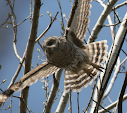
Saturday along the Front Range in Colorado was overcast and chilly, but not wet, so a good chance to go after a few of the rarities that had been reported in the area but which I had not yet successfully located. I started the day in Broomfield, looking at gulls, but those are a story for a later post. For the moment I am going to jump ahead, and North, to Weld County. I headed there in hopes of seeing the immature Red-shouldered Hawk, which has been wintering out of range at the Kodak Watchable Wildlife Area. On the way I exited the Interstate a few miles south and swung into the Elwell Cemetery outside Johnstown to check the evergreens. It wasn't a wasted stop, seeing a Great Horned Owl sleep peacefully was well worth it.
Eventually, I did reach the outskirts of Windsor and the Kodak Watchable Wildlife Area. I have been reading reports about this bird for several months now, and on one previous rushed attempt had failed to locate it. This time I was committed though. I had no deadlines to meet, and having visited once before was able to process the descriptions of the birds habits better against the landscape. I heard it before I spotted it, and true to its description, my first glimpse of this easily spooked bird was as it settled into a tree on the south side of the river.
Shooting into the sun through a heavy overcast yielded poor results, but note the high degree of white in the back. That alone wouldn't have sealed the ID, even with my impression of the short single note call that was higher and shorter than that of a Red-tail. But this next shot captured a tell-tale field-mark in an otherwise trashable shot. That buffy patch towards the tip of the wing is a distinctive field-mark for a juvenile Eastern Red-shouldered Hawk. Knowing that the same bird was the one I was looking for helped as well, but I was still happy to find the bird and capture a conclusive - if poor quality - shot.

The Red-shouldered Hawk wasn't the only bird around by any means. A group of 20 Western Meadowlarks were singing in the scrubby trees surrounding a marshy area. Their song, the first I had heard this year, attracted the attention of a Northern Harrier, which was making low slow passes around the area.

Finally, as I returned to the parking lot I noticed a group of large birds in a distant Cottonwood tree. The group of Bald Eagles illustrates the difference between adults and 2nd (possibly one 3rd) year birds. Note how the juvenile looks a lot like a super-sized Swainson's Hawk with the dark bib on a light body? The bird on the left has its back turned and shows the small light triangle across the shoulders and upper back. Again, not the best picture, but one that shows them in the distance against a gray background, much as they often appear when driving along a highway at high speed.

The Red-shouldered Hawk wasn't the only bird around by any means. A group of 20 Western Meadowlarks were singing in the scrubby trees surrounding a marshy area. Their song, the first I had heard this year, attracted the attention of a Northern Harrier, which was making low slow passes around the area.

Finally, as I returned to the parking lot I noticed a group of large birds in a distant Cottonwood tree. The group of Bald Eagles illustrates the difference between adults and 2nd (possibly one 3rd) year birds. Note how the juvenile looks a lot like a super-sized Swainson's Hawk with the dark bib on a light body? The bird on the left has its back turned and shows the small light triangle across the shoulders and upper back. Again, not the best picture, but one that shows them in the distance against a gray background, much as they often appear when driving along a highway at high speed.
2010 Count: 58
Lifetime: 205




No comments:
Post a Comment